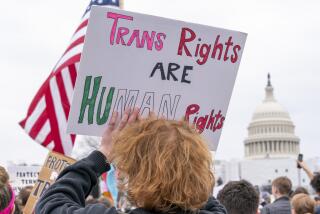Justices’ Heaviest Lifting Is Ahead
WASHINGTON — As the Supreme Court heads into the final month of its term, the new chief justice has shown a knack for finding ways to decide cases on narrow issues that have led to unanimous rulings.
But June is rarely the time for harmony and unanimity at the high court.
For the record:
12:00 a.m. June 1, 2006 For The Record
Los Angeles Times Thursday June 01, 2006 Home Edition Main News Part A Page 2 National Desk 3 inches; 132 words Type of Material: Correction
Supreme Court: An article Tuesday in Section A about cases still to be decided by the high court this term said Chief Justice John G. Roberts Jr. explained his desire to press for narrow rulings over broad pronouncements this way: “If it is not necessary to decide more to a case, then in my view it is necessary not to decide more to a case.” The quote should have said: “If it is not necessary to decide more to dispose of a case, in my view it is necessary not to decide more.” Also, a chart that listed the pending cases said a whistle-blower lawsuit arose when a Los Angeles deputy sheriff alleged he was moved to a less desirable job for reporting police misconduct. The employee was a deputy district attorney.
The justices tend to put off the most difficult cases to the end of the term, and this one is no different. The court faces major decisions on terrorism tribunals, wetlands protection, lethal injection, domestic violence prosecutions and campaign finance limits.
The final cases could test whether Chief Justice John G. Roberts Jr. can extend his record through his first term on the court, which he acknowledged could be a challenge in a recent talk to Maryland judges.
“I do feel at this point a bit like the fellow who jumped off the Empire State Building, passed the 50th floor and said, ‘So far, so good,’ ” he joked. “The hard part’s coming up.”
In all, 37 cases remain to be decided by the end of June. Unlike in years past, however, the justices will not face end-of-term decisions on issues that typically divide the court along ideological lines, such as religion, affirmative action, abortion and gay rights.
In one highly anticipated case, the court could deal a rebuke to President Bush and the Defense Department for their plans to put some prisoners at Guantanamo Bay in Cuba on trial for war crimes in special military courts.
Defense lawyers and civil libertarians say the military courts have not set fair rules and do not adhere to international standards for war crimes trials.
That decision, however, will not bear the imprint of the new chief justice. He is sitting out the case because he heard it when he was on the U.S. Court of Appeals and ruled in favor of the administration’s position.
Meanwhile, property rights advocates hope Roberts and the court will sharply cut back on the reach of the federal law that protects wetlands and streams by deciding that it applies only to “navigable” waters.
The Clean Water Act seeks to protect the nation’s rivers, bays and lakes from pollution. Since the 1970s, environmental regulators have cited it to stop the dredging of wetlands and the flow of tainted drainage into small streams because the pollution will end up in lakes and bays.
The Bush administration has linked up with environmentalists to protect the broad reach of federal anti-pollution law.
And the court could make it far harder to prosecute domestic violence. Because victims are often afraid to testify in court, prosecutors commonly use their tape-recorded calls to 911.
Justice Antonin Scalia, however, has said defendants have a right to confront their accusers face-to-face in court, and he may persuade a majority to halt prosecutions based on out-of-court statements.
Most of the remaining cases will not change the law in a significant way, and many may be resolved on narrow issues.
For example, the justices in January stopped Florida’s planned execution of Clarence Hill, the murderer of a police officer whose many appeals were rejected. His defense lawyer said he was not challenging Hill’s conviction or death sentence, but the method of execution.
Challenges to lethal injection have been filed in many states, including California. U.S. District Judge Jeremy Fogel in San Jose has scheduled a hearing in September on whether the state must change its lethal injection procedures.
Some doctors say the drugs commonly used in lethal injections may, if wrongly administered, cause excruciating pain.
But the Supreme Court justices might decide only a procedural question: Can a state inmate win a new hearing in federal court after his final appeals have been rejected? If the justices do so, the court will put off for another day the ultimate question of whether such injections amount to cruel and unusual punishment.
Roberts has established that he intends to steer his court toward such narrow rulings.
This month, the court decided eight cases, and all were unanimous. Sometimes, however, the ruling skirted the most difficult issue.
For example, an Ohio case tested whether states could give special tax breaks to lure big corporations to build new factories there. A lower court, siding with some disgruntled taxpayers, said the tax breaks were unconstitutional.
Roberts, writing for the court in DaimlerChrysler Corp. vs. Cuno, threw out the lawsuit on the grounds that the taxpayers did not have standing in federal court to challenge the state’s policy. The decision sent the case back to a state court to start again.
In January, the court even managed to resolve an abortion case with a narrow, unanimous ruling. The justices revived a New Hampshire law that required doctors to notify the parents of girls under age 18 two days before they performed an abortion, but the justices also said there must be an exception for medical emergencies.
The chief justice recently explained to Georgetown law school graduates his desire to press for narrow rulings over broad pronouncements. “If it is not necessary to decide more to a case,” he said, “then in my view it is necessary not to decide more to a case.”
*
(BEGIN TEXT OF INFOBOX)
Topping the court’s docket
Here are 10 of the most important questions the Supreme Court will confront in June, the last month of its term.
War on terrorism
Can the Bush administration try detainees at Guantanamo Bay in special military courts? This is a clash between Bush’s claim of war powers and Geneva Convention rules. (Hamdan vs. Rumsfeld)
Texas redistricting
Can Texas redraw its electoral districts in mid-decade to give the Republican Party more seats in Congress? At issue is a redistricting plan engineered by former House Majority Leader Tom DeLay. Such plans are usually drawn only once a decade based on the census. (League of United Latin American Citizens vs. Perry)
Campaign spending
Can Vermont strictly limit how much state candidates spend on campaigns? The state is challenging the 1976 Supreme Court ruling Buckley vs. Valeo, which said federal candidates had a free-speech right to spend as much as they wanted. (Randall vs. Sorrell)
Whistle-blowers
Does the 1st Amendment protect government whistle-blowers from being punished for reporting wrongdoing? This case arose when a Los Angeles deputy sheriff alleged he was moved to a less desirable job for reporting misconduct by the police. The outcome could affect the rights of 21 million public employees. (Garcetti vs. Ceballos)
Domestic violence
Can the government prosecute domestic assaults based not on courtroom testimony of the alleged victim but on taped 911 calls? A ban on such evidence would make it much harder for prosecutors to pursue cases when the victim can’t or won’t testify. (Davis vs. Washington and Hammon vs. Indiana)
Wetlands
Does the Clean Water Act protect inland streams and wetlands, or is this federal anti-pollution measure limited to navigable rivers, lakes and bays? If a Michigan developer prevails, it would greatly limit the reach of a key environmental law. (Rapanos vs. United States)
Lethal injections
Can death row inmates file a last-minute appeal after losing all previous appeals to challenge the method of execution as cruel? Lawyers for a Florida murderer won a stay on the day their client faced execution, citing studies that suggested a drug used in executions may mask an inmate’s pain. (Hill vs. McDonough)
DNA
Can a death row inmate win a new trial after showing that new DNA analysis refutes some of the evidence against him? Paul House was sentenced to death for the rape and murder of a neighbor, but DNA tests showed he did not have sex with her. (House vs. Bell)
Foreign felons
Do foreign prisoners in the United States have a right to reopen their cases if they and their consulates were not informed of their rights at the time of their arrest? The World Court ruled that the Vienna Convention gives legal rights to Mexican natives imprisoned in the United States. (Sanchez-Llamas vs. Oregon)
Retaliation
Can an employer be forced to pay damages for transferring a worker to a lesser job after she has filed a complaint of sexual harassment? Employers say retaliation claims, such as this one involving a woman who was removed from her job as a forklift operator, are the fastest-growing kind of discrimination cases. (Burlington Northern vs. White)
Graphics reporting by David G. Savage
Los Angeles Times
More to Read
Sign up for Essential California
The most important California stories and recommendations in your inbox every morning.
You may occasionally receive promotional content from the Los Angeles Times.











